Five days. Four nights. A desolate seaside hike along Portugal’s abandoned coast. At least that’s what was advertised.
The Fisherman’s trail is a growing in popularity 4-14 day town to town hike along Portugal’s south Atlantic coast. The original four day trail ran from Porto Covo to Odeciexe [Oh-deh-seesh], built out of historic cliffside trails that fisherman would use. It has recently been expanded 10 days to finish in Lagos, along the Algarve coast. We decided to attempt five legs from Aljezur to Porto Covo, heading south to north. Each leg ranged from 16-22km, treading a mixture of roads, gravel trails, dirt paths and sand.
When researching this trail online, it was not recommended to do it in the summer due to the heat. It also made little mention of trail conditions, with some sandy patches near Porto Covo mentioned. As a result, we prepared ourselves by starting our hiking days early in the morning. Baggage services were not running in the summer, so we carried all of our stuff on our backs, including all of our winter gear for the Andes mountains in the future, and all of our electronics and non-essentials.
Day 1: 14.4km, 177m elevation, 5 hours 28 minutes
Rogil to Sao Miguel
We got on the bus in Lagos, with the initial plan of getting off in Aljezur for a 22km day to Odeciexe. We decided on the way to cut off the first 8km of the day, an inland portion, and instead start in Rogil, where we would walk 3km along roads to the ocean. This was a very good decision in the end. The weight of our packs was apparent quickly (we weighed each of our packs at 28lb, and the day pack at 10lb before the trip. We were also carrying 4L (9lb) of water per day, which puts each of our packs at an estimated 35-40lb each) but on the solid asphalt or gravel it wasn’t much of an issue. After an initial bout of overconfidence and blister management, we made it to the ocean. The view was unbelievable.
We were perched high along a cliff face. The land appeared to suddenly stop, with jagged dark metamorphic rocks jutting out of the landscape, as if the other half of the world had been pulled apart from it. Cliff faces had collapsed into the sea, the directions of their shale vastly different to the land. Waves were breaking over the small rocky outcroppings, continuously drowning them as the tide rolled in. The sound was overwhelming as well. A load roar of fury constantly crashing down until the end of the horizon in either direction. This view was one of the most spectacular of the trip, only competing with similar views elsewhere on the hike.
We continued along the cliff face shifting between walking in dirt and sand. The sand became very tough to walk in with our packs on. Each step required the power of two. But the landscapes that we were seeing made it so that we didn’t care. The whole area was spectacular.
We eventually arrived at Praia do Odeciexe, a large beach where a river meets sea. We set our packs down to play in the surf, but it was vicious. There were many surfers out in the sea trying to catch a wave, none ever got that successful.
Food and water were running low, so we decided to finish our day. There is no way across the river except for a bridge 3km inland at Odeciexe (or swimming), so we turned towards the town. We walked through a cow pasture, which was cool. Our campground was another two km inland walking uphill along a road in Sao Miguel, which wasn’t really a welcome surprise. When we got there though, it was nirvana. There was a little pool, a supermarket to stock up on food for the next day and a restaurant (which was terrible. We barely ate our meals, then bought chips and candy for dinner instead). We set up our tent to sleep in, and being in the little purple cover felt like home. We crashed early, and had a great sleep.


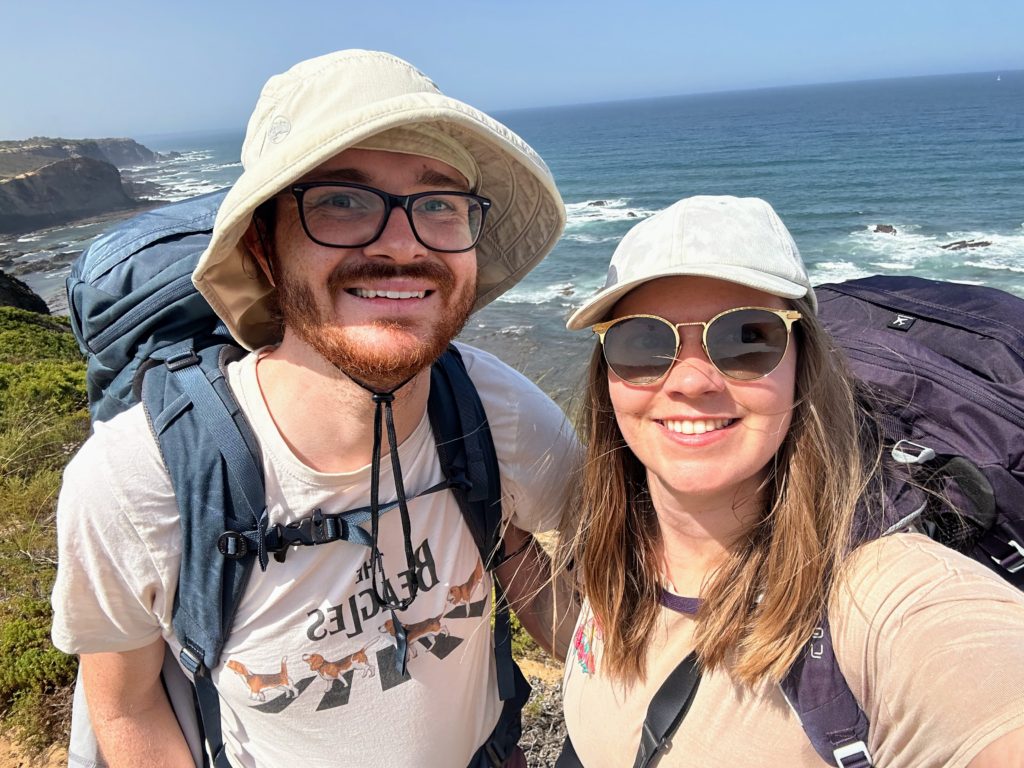

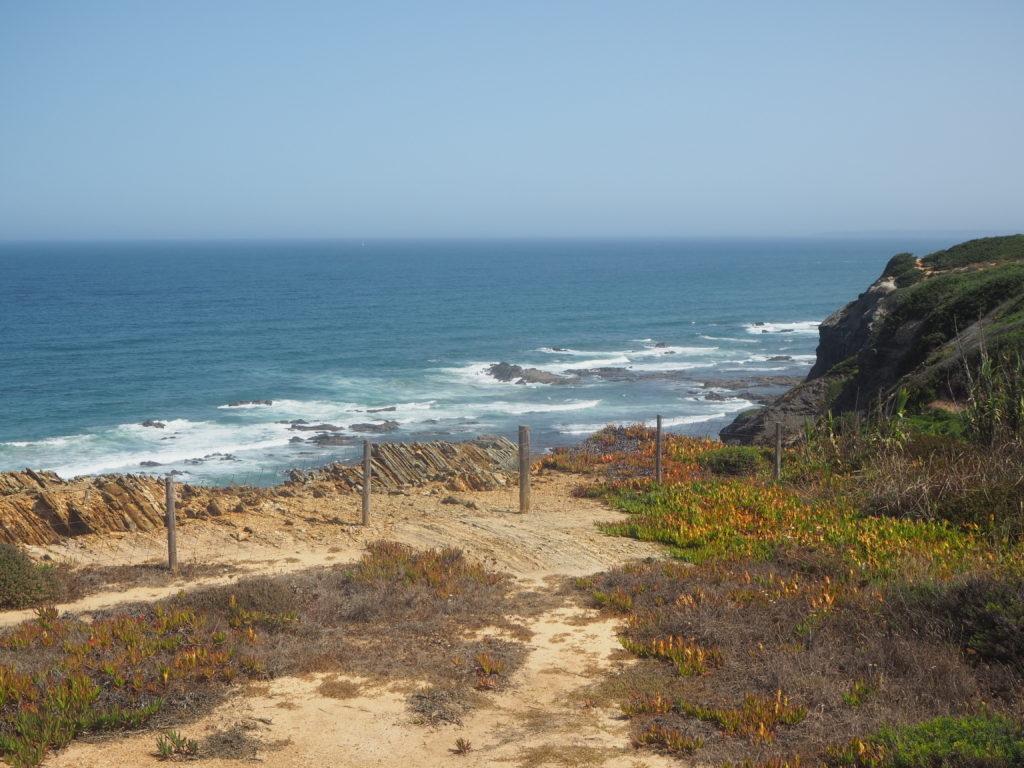
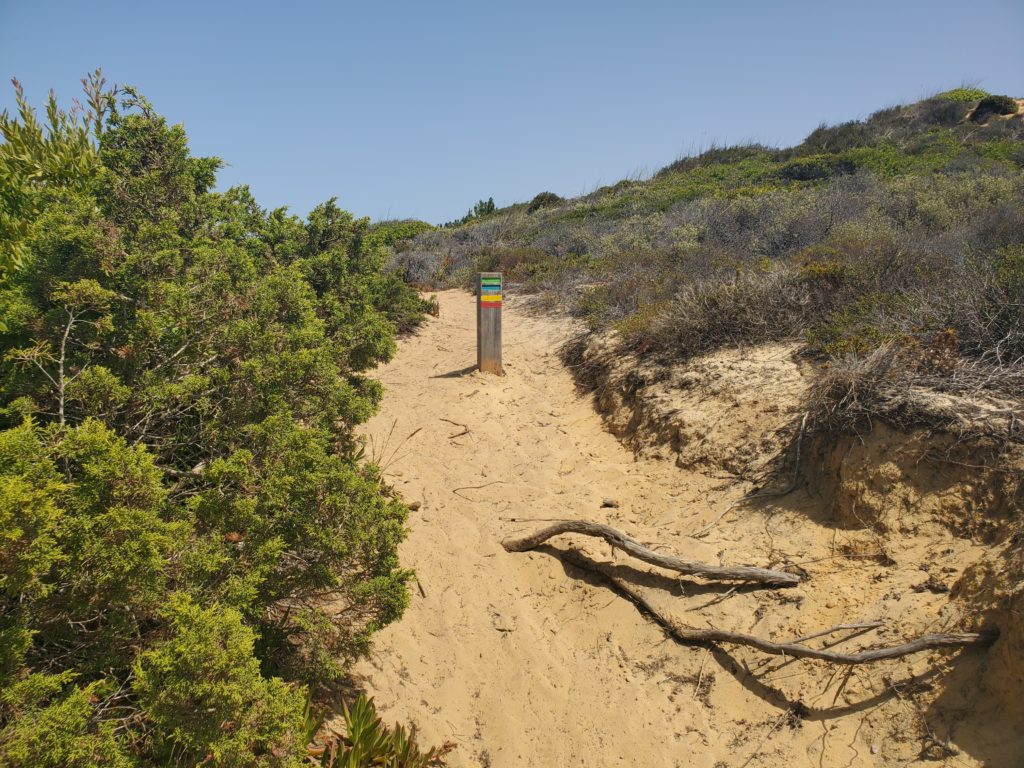
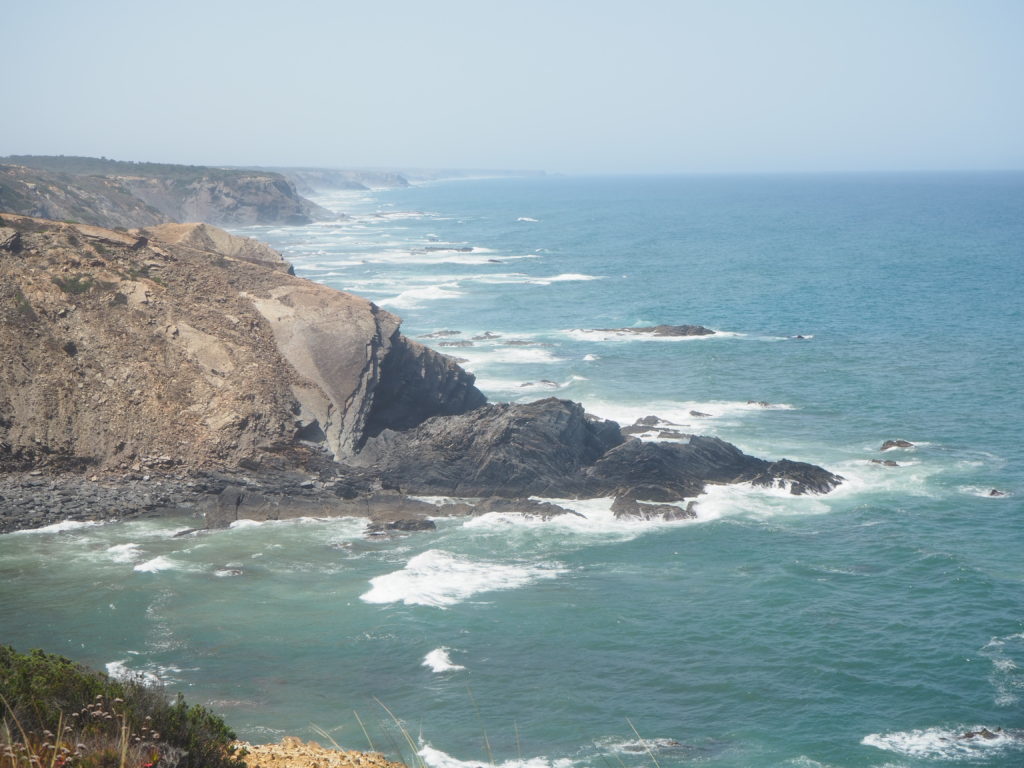
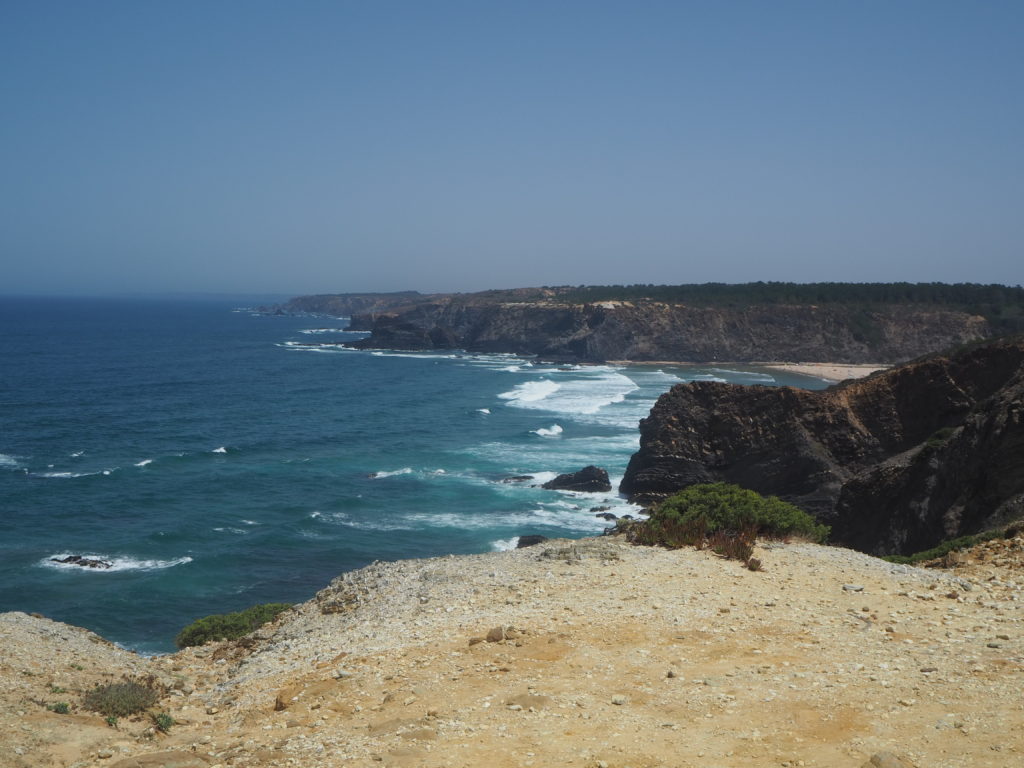
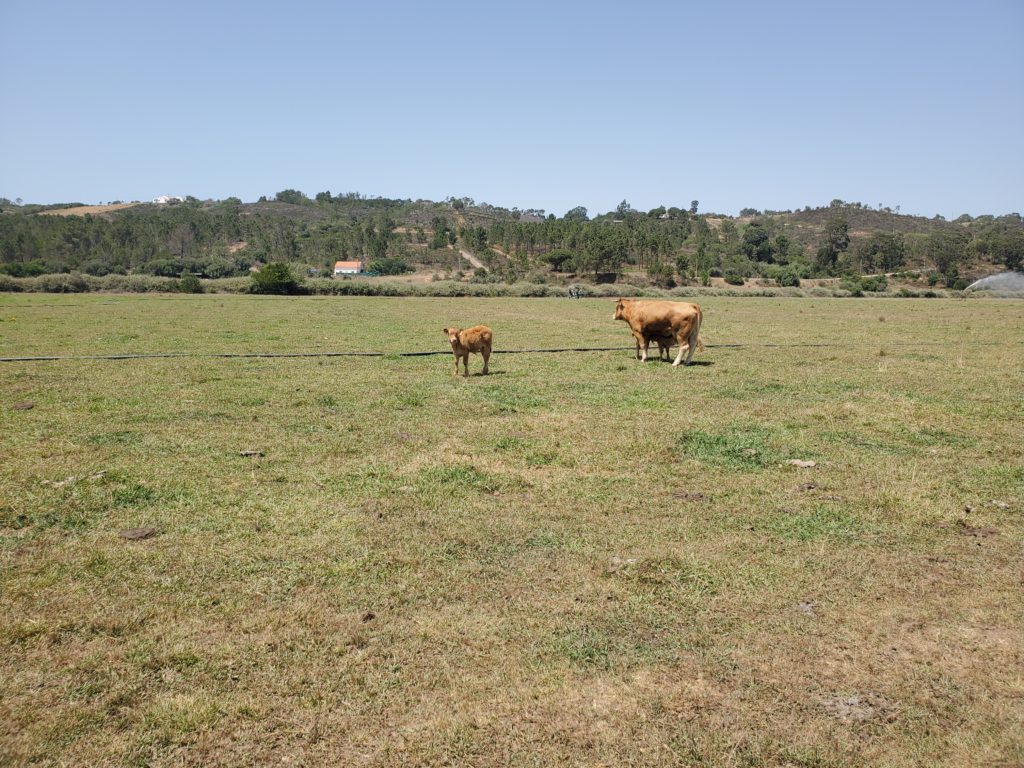
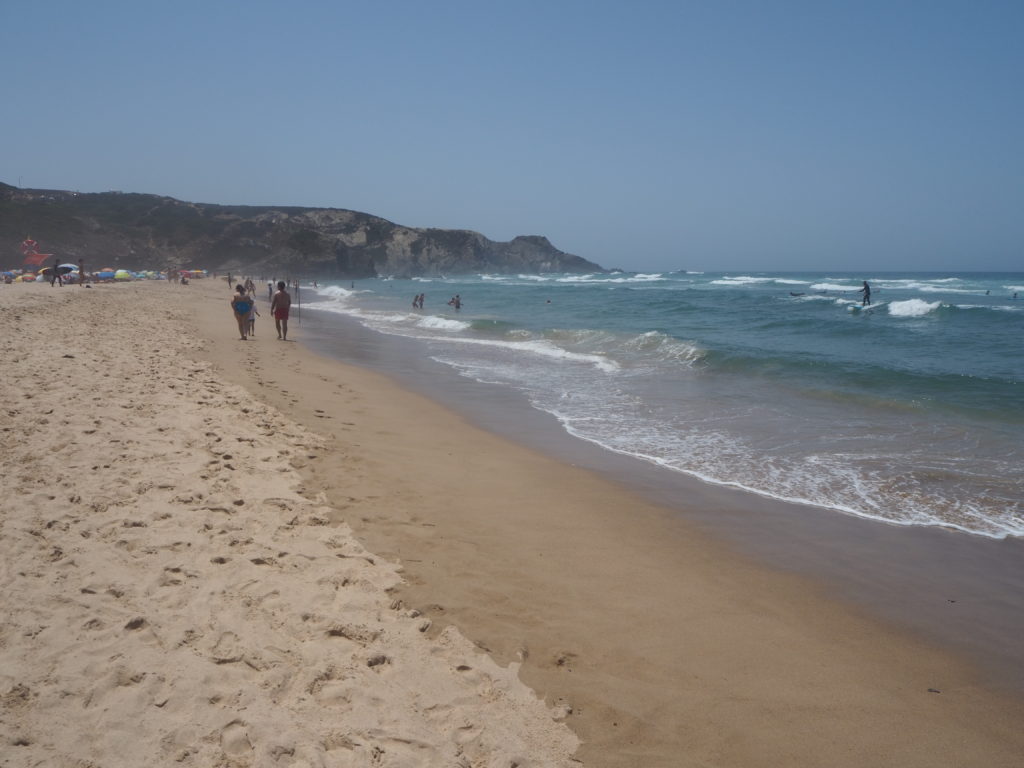
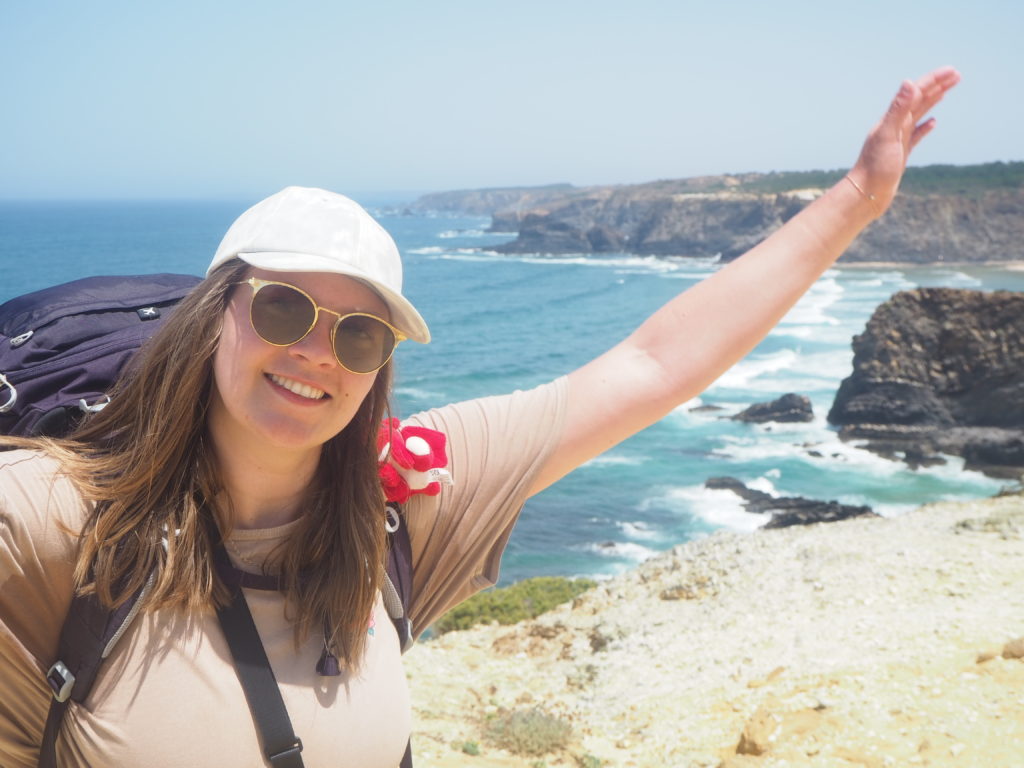
Day 2: 20.6km, 410m elevation, 7 hours 56 minutes.
Sao Miguel to Zambujeira do Mar
We should clarify that our times are sleeping point to sleeping point. The first 6km of the day took 1h15min, as we powered along to roads to a beautiful lookout for breakfast at 8:30am. We passed three fellow hikers that looked like they had some tough decisions to make regarding their day. Breakfast of jam and nutella bread was fantastic, and we began to follow familiar looking trails along the cliffside north.
The cliffside trails were unlike anything we have ever seen in Canada. The vegetation was devoid of grasses or mosses. It’s a mixture of succulents and shrubs with some large bushes that you crash through mixed right in. There was no dirt, only sand that the plants were growing out of. Some areas of the trail were larger, with what appeared like ATV tracks, and they were filled with a lighter imported sand, which was extra hard to walk in. There were a couple small hills that consisted of the imported mess, and with our packs, those 30m up had our legs screaming.
At the top of one of those hills we met Karem, a German hydrology student. We had passed him and his friends earlier in the day, and two of them decided to bus to Zambujeira, as one was not up for the hike today. As a result, he was carrying essentially nothing. We hiked with him for the next hour or so to Azhena do Mar, where the three of us stopped for a coffee and pastries. He was lovely to chat to, and we chatted about our schoolings. He is very passionate about mitigating erosion from heavy rainfalls and floods. Azhena do Mar was a very quiet fishing town when we arrived.
Karem carried on ahead of us, and we slogged our way though the sands and gravel roads up the coast. The views are still remarkable around every turn. Each cove is a different formation of rocky patterns in the sea, with different crashing sounds coming from each one. Sometimes due to private land, the trail turns inwards to head around some sort of farm. The farms were interesting, as every plant was growing in sand. We recognized lettuce and grapes as two of the crops.
There were a decent amount of hikers going each direction on the hike. We were some of the slowest. We also had, by far, the largest packs of anyone we saw. There was a dude we saw a few times in those barefoot toe shoes who kept doing push ups. Karem caught up to us again, with more friends, as he had stopped at a beach somewhere along the way. We tried to keep up with the new trio for a while, but they were a little too nimble for us, and they left us behind. We all experienced a zoo/ exotic pet ranch together. We walked on the other side of a large enclosure, postulating what it could be. One of us joked “what if we turn the corner and there’s a rhino,” and then seconds later an emu showed up. We also saw an ostrich, wildebeest, bison and zebra all in the same enclosure.
We made it to our favorite seaside town, Zambujeira do Mar. Karem and his friends were staying there, so it was nice seeing all of them eight hours after passing them in the morning. Zambueijra beach is a gorgeous patch of sand carved out of the cliffs. A small stream runs through it, attracting every 10 year old boy to try and build a dam to stop the flow. Bodyboarders are having little luck in the deep waves, and families are splashing together in the shallows. Multiple versions of paddle games are played, some with makeshift courts drawn in the sand. We must have spent an hour in silence sitting above it, watching the power of the sea.
Zambujeira was where we decided to make our next stab at a really good European meal. We tried a highly recommended seafood joint, but it was all reserved out. We settled for a pizzeria, and proceeded to not order pizza. We got Portuguese style steak, which is a steak in a vinegary gravy surrounded by potatoes, and chef style cod, which is a deep fried cod with skin and bones, acidic veggies, and surrounded by potatoes. Cam quite liked her steak, even if it wasn’t that expected, and my cod tasted like anxiety, as I never know if the crunch was a deep fry or bones.

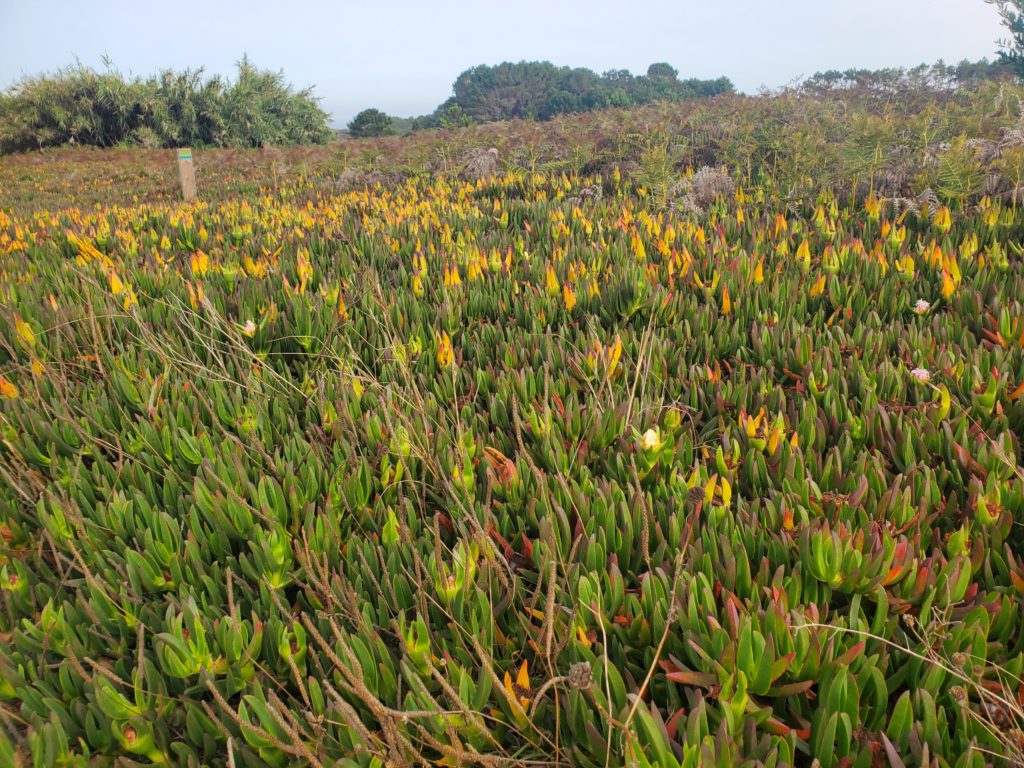
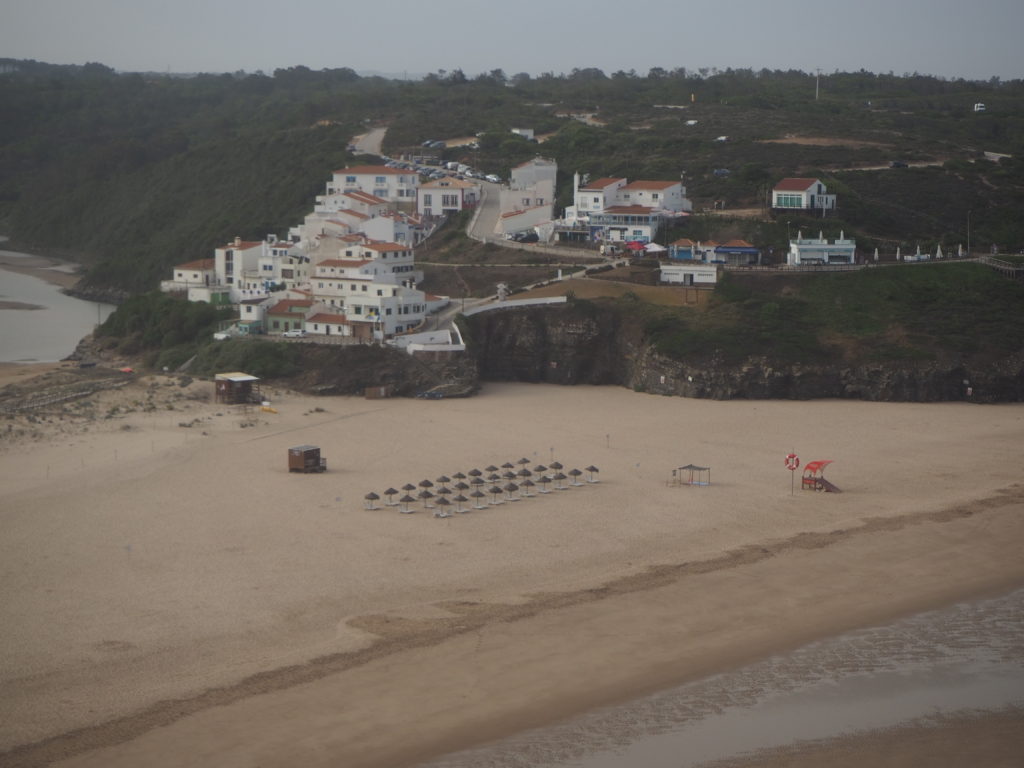
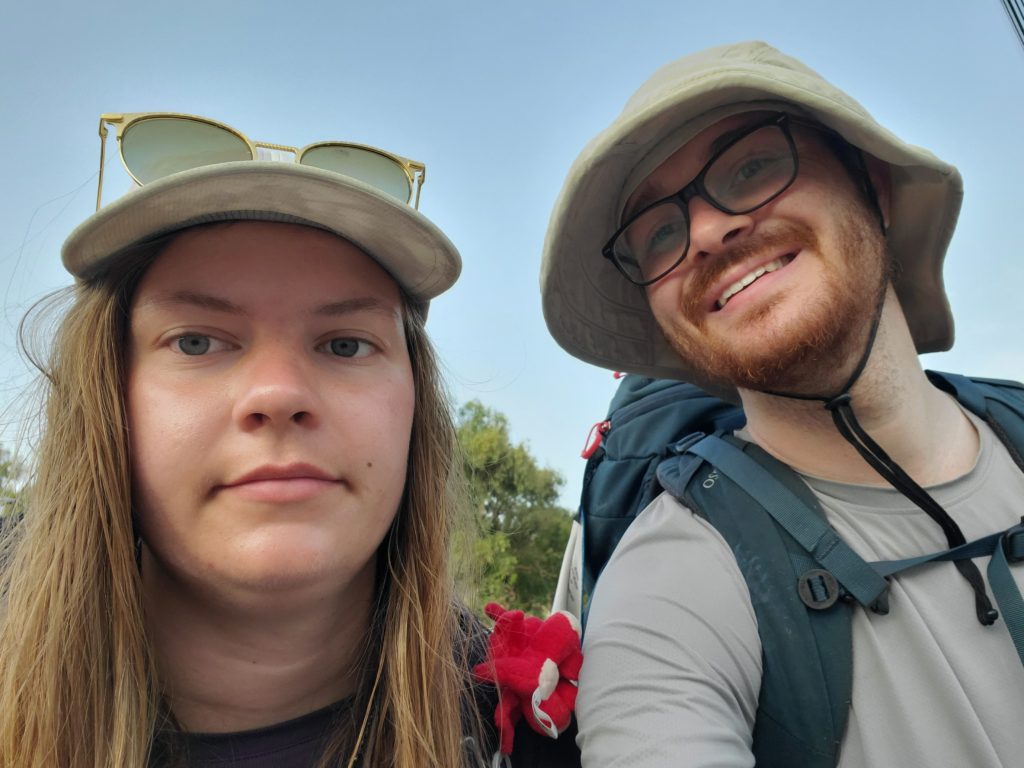
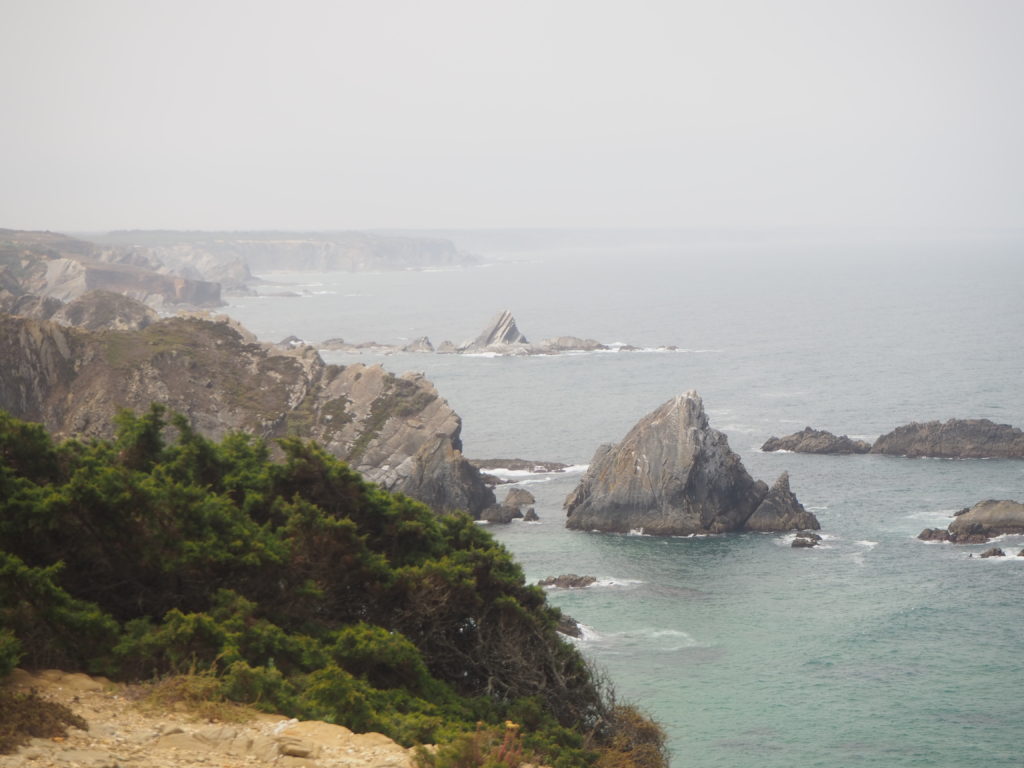
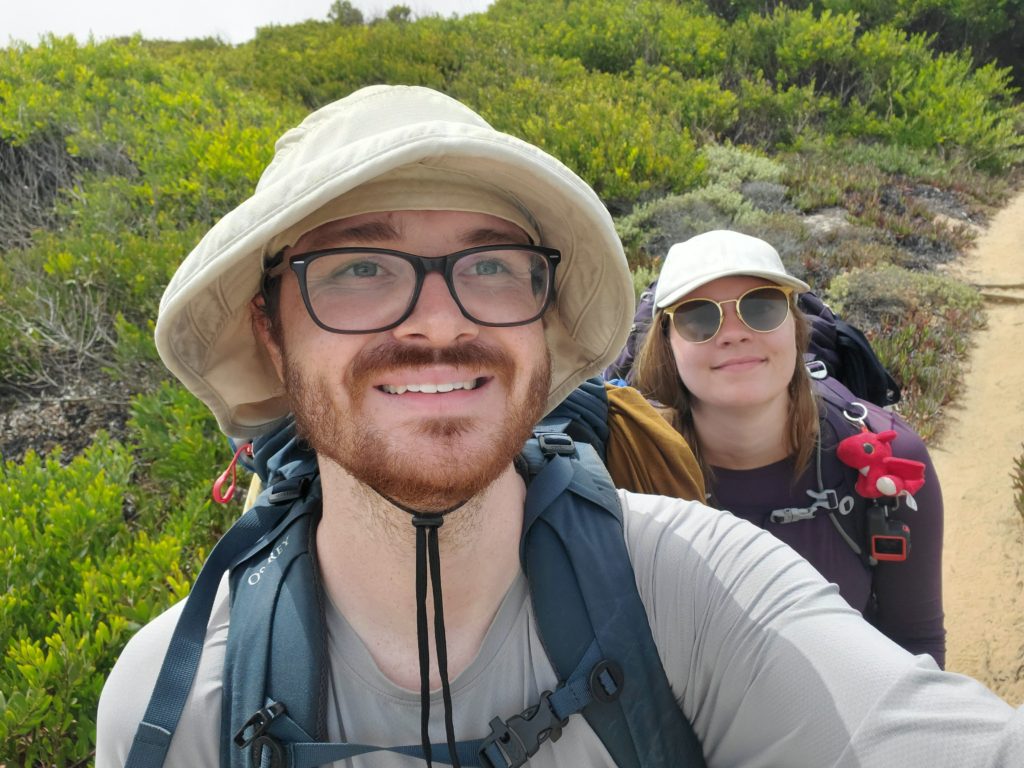
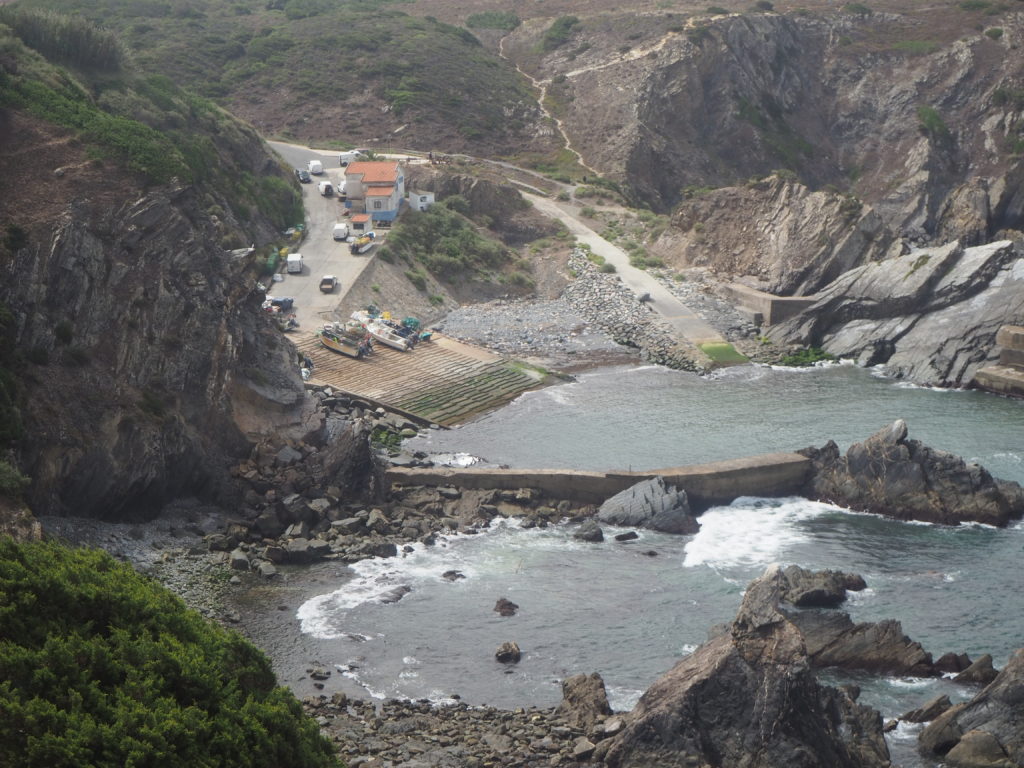
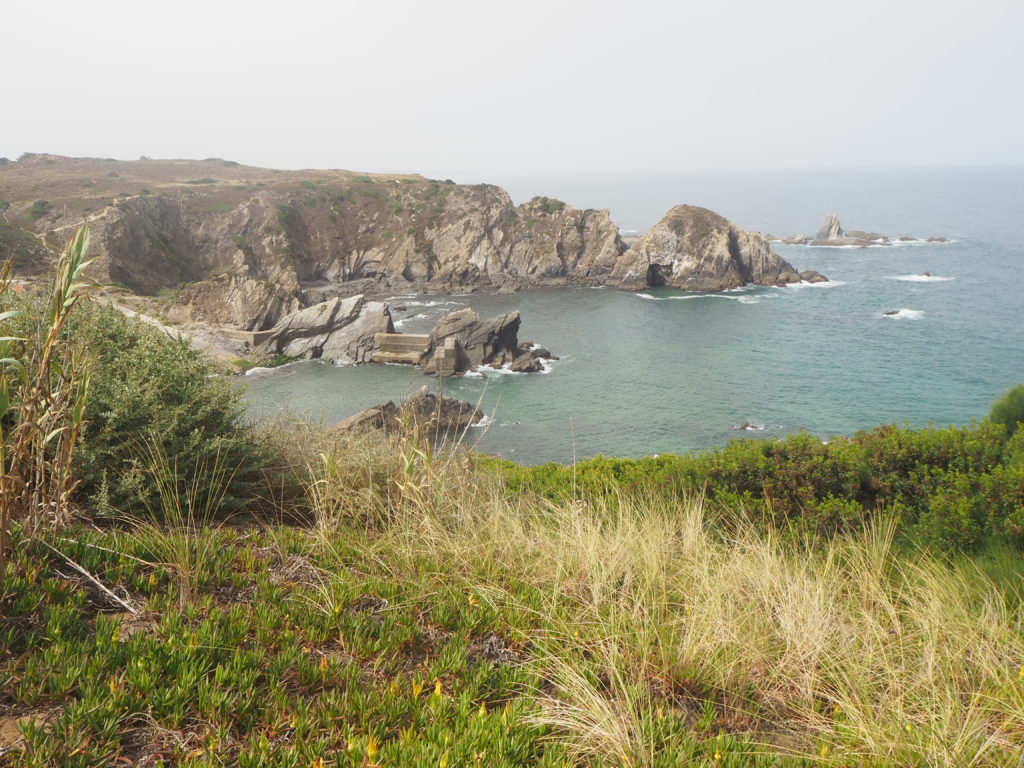
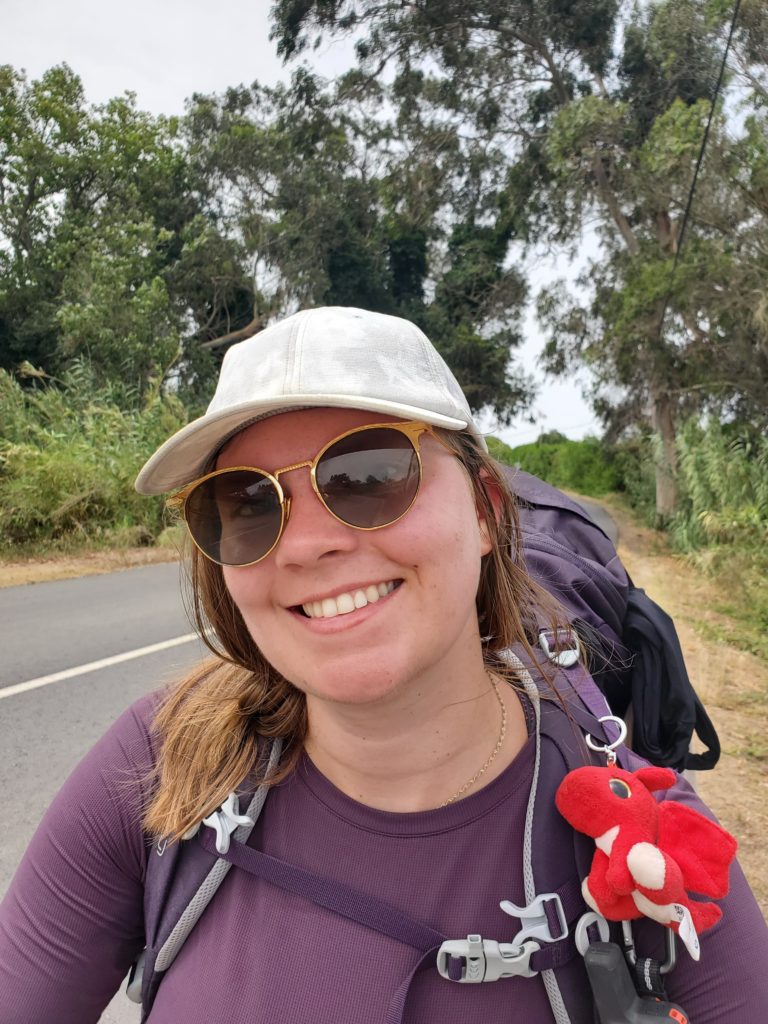
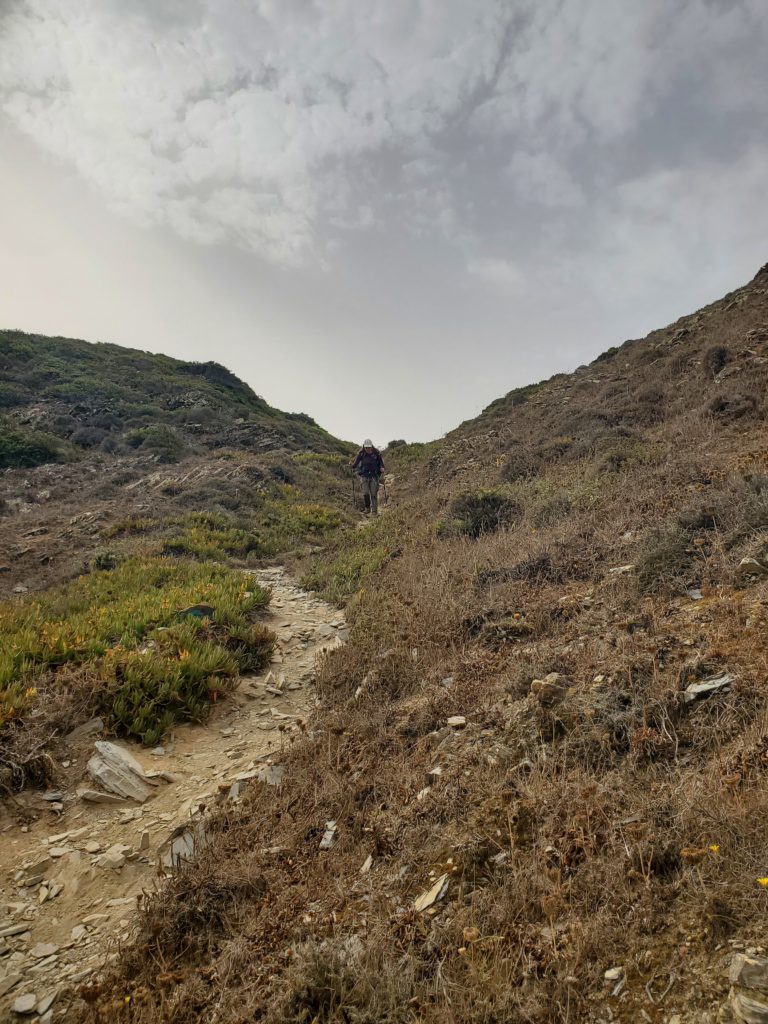

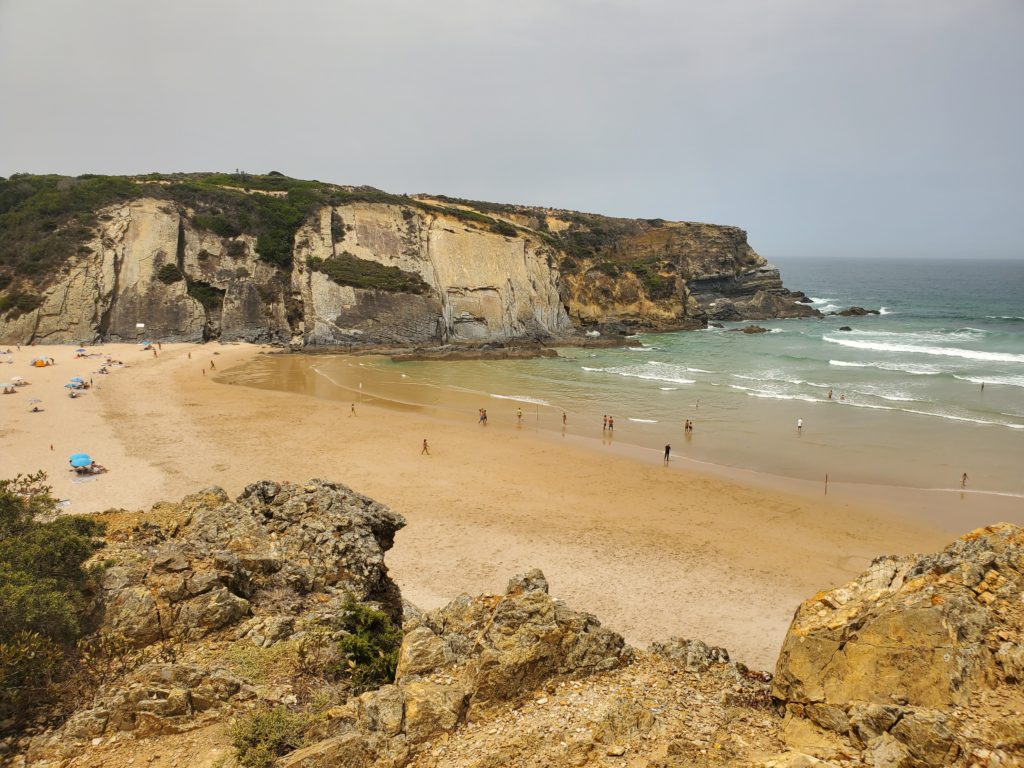
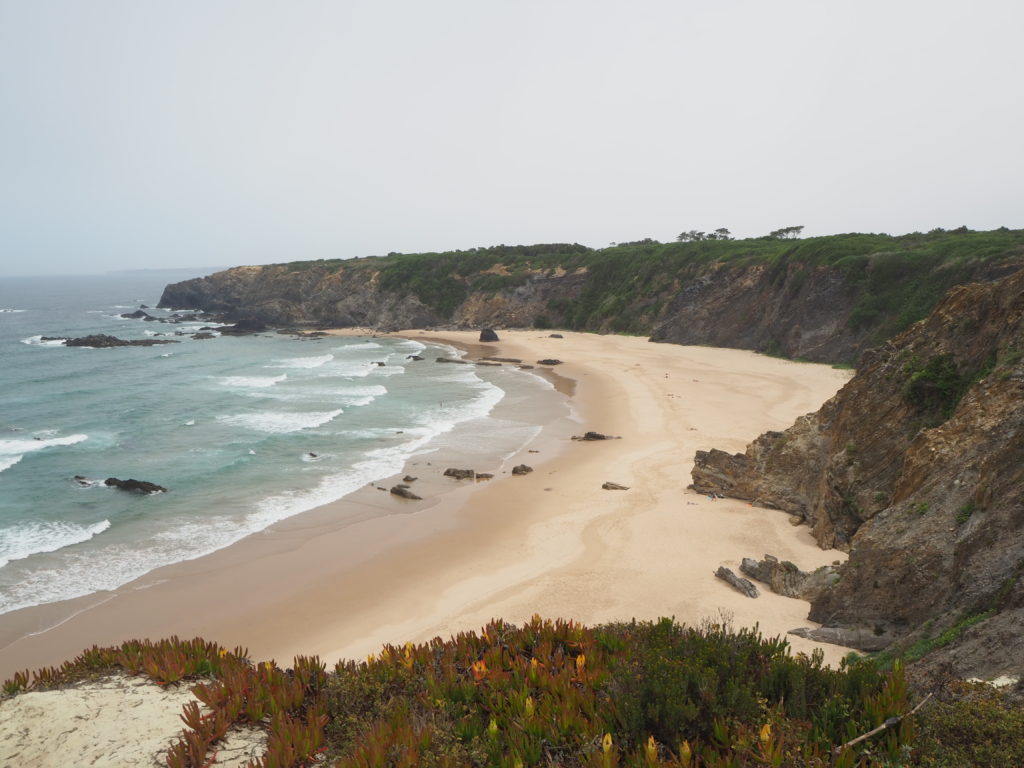
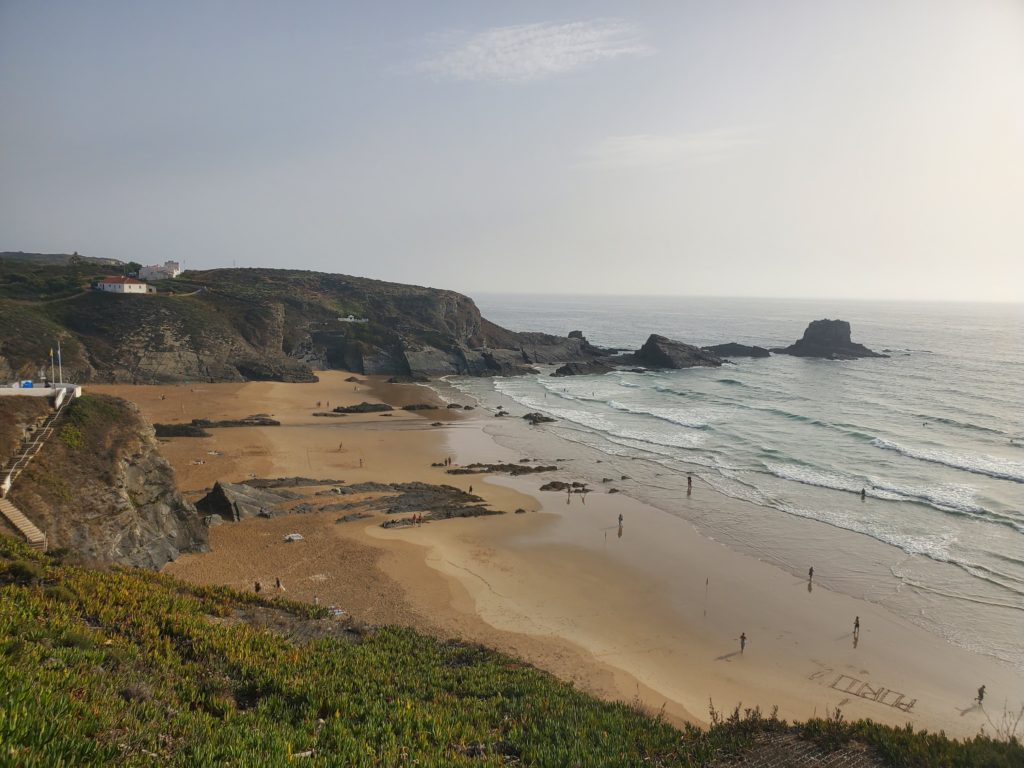

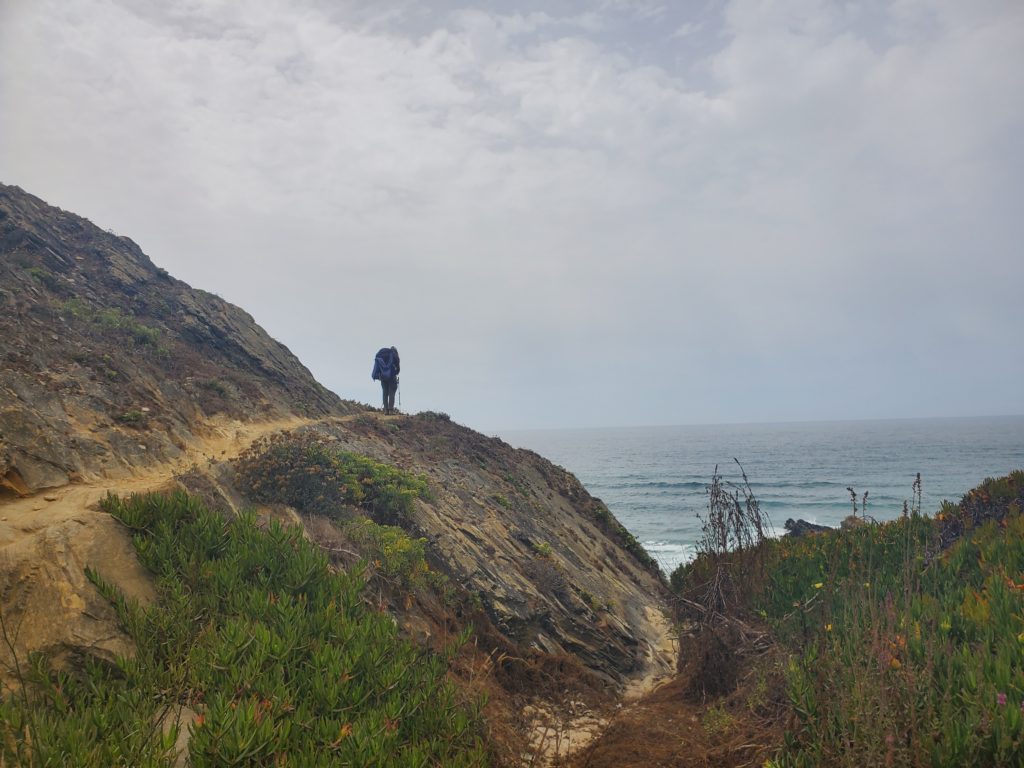

Day 3: 22km, 20 minute bus ride.
Zambujeira do Mar to Almograve.
We woke up sore on Day 3. Cam had rolled her ankle the day before, and I discovered new foot muscles that I never knew I had. Our shoulders were also very tight. So we decided to skip the 22km of sand that lay before us, and opted for a 20 minute mid afternoon bus ride instead.
Our morning consisted of hanging at the beach, and adding our contributions to the damming of the stream. We then made it into the seafood joint we failed to the night before, and had a very delicious surf and turf spread. Blackened pork, tiger prawn, fries, rice, beans, salad, grilled pineapple, mushrooms and corn, and a garlicy crème fresh sauce lay before us. This was the meal we had been craving since the start of our trip, and it was fantastic. Everything was flavorful. The textures complimented each other well. The multiple starches were a welcome addition. The pineapple provided punch, the beans a softness. It was delicious.
We caught the bus to Almograve, another sleepy seaside town. When we told our host we skipped the day, he told us that that was a good call. Good for us I guess. We decided that we had one more day of hiking in us, 16km to Vila Nova de Milfontes, and we were going to skip the 5th day. We were tired of the sand.
We had been spending so long trying to find our European meal, found it, then had that immediately outshone by a random Nepalese/ Indian food joint on the outskirts of town. We had some lovely curries, and spent a good amount of time eavesdropping on a disastrous date going on beside us. A French man in his 60s was trying to impress an equally aged English speaking American woman with all sorts of world politics and philosophy conversation, and she wasn’t having any of it. We always love dinner with a show.
We ran to the beach to catch the sunset. The beach must have been a kilometer long, with waves and the last glimpses of sun kissing the expanse of sand that lay before us. We took a cliché long romantic walk on the beach and enjoyed every moment of cheesiness. It was a fantastic.

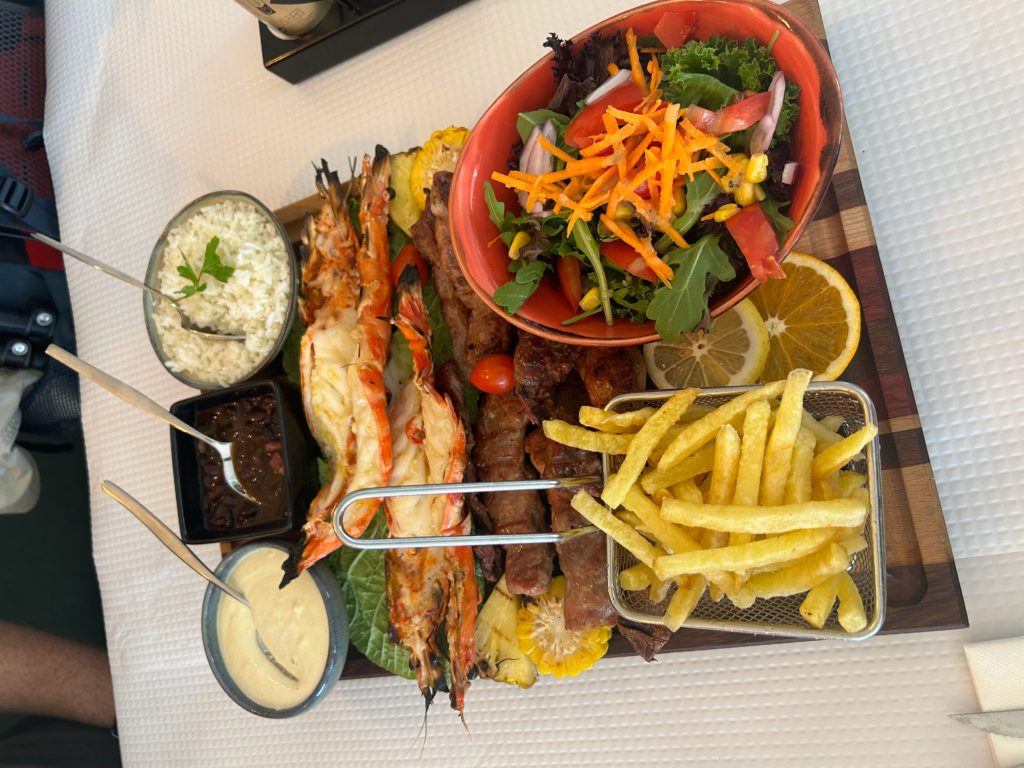

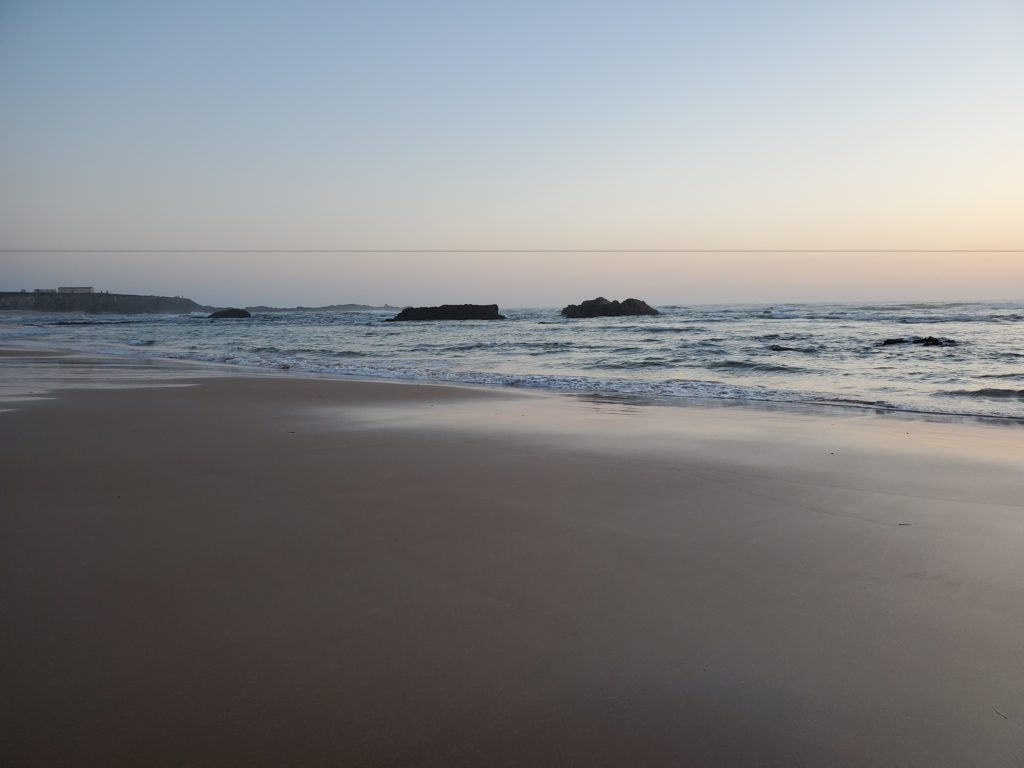

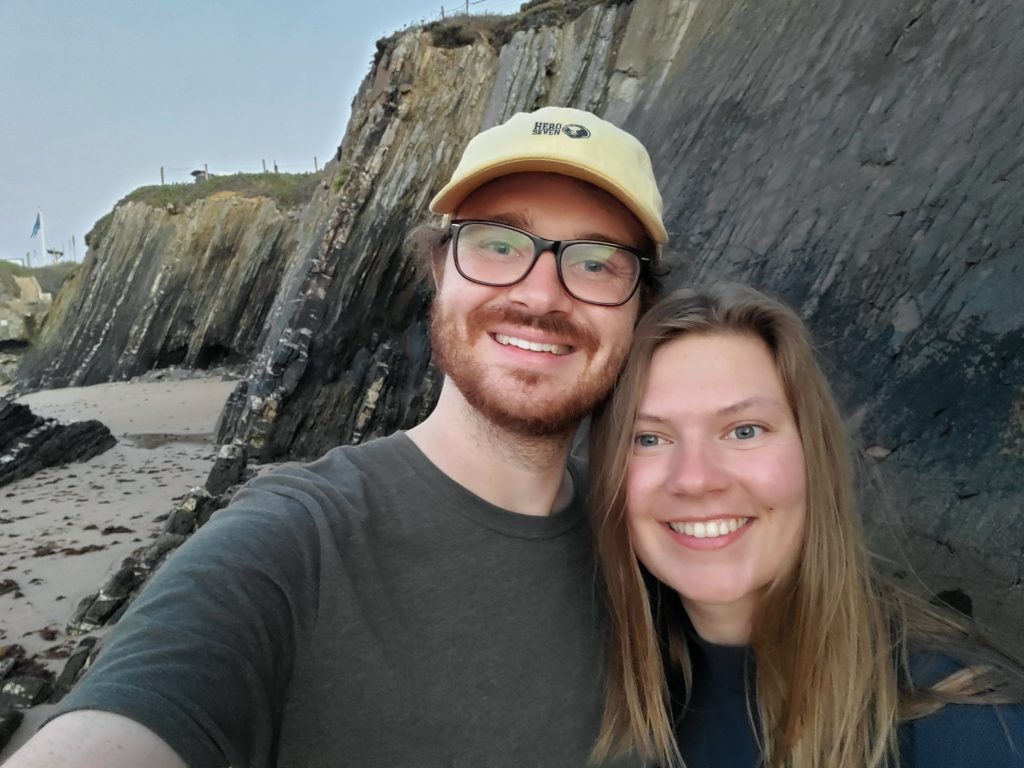
Day 4: 11.1km, 125m elevation, 2 hours 49 minutes
Almograve to Vila Nova de Milfontes
No sand. That’s that they said. No sand. Jokes on us. Imported sand everywhere. Everywhere!
Halfway through today we decided that the Fisherman’s trail should be a two day experience. We spent most of today somewhat inland from the coast, navigating through the brush. The coastal views were still gorgeous, but we got over the sand and the extra weight of our bags pretty quick. We ended up at a beach, and decided to Uber the last 4km that would have been walking along roads.
We spent the afternoon resting from our three day hike. Cam crushed the book How to Kill Your Best Friend by Lexie Elliot. The murder mystery novel was an easy read 6.5/10. I zoned out. We had sushi for dinner, and explored the town, which was teeming with night life. The 20km leg to Porto Covo is apparently all sand, so that will be it for the hiking for us.
Overall, the hike was a worthy experience, but the best sections were definitely the first two days. The spectacular views got repetitive, but were diminishing returns with the obstacles of the weight and the sand. The whole 14 day stretch would be lovely and doable in a later season, with a lighter pack. We got lucky with the weather, there were only highs of mid 20s, and it was cloudy all of day 2.
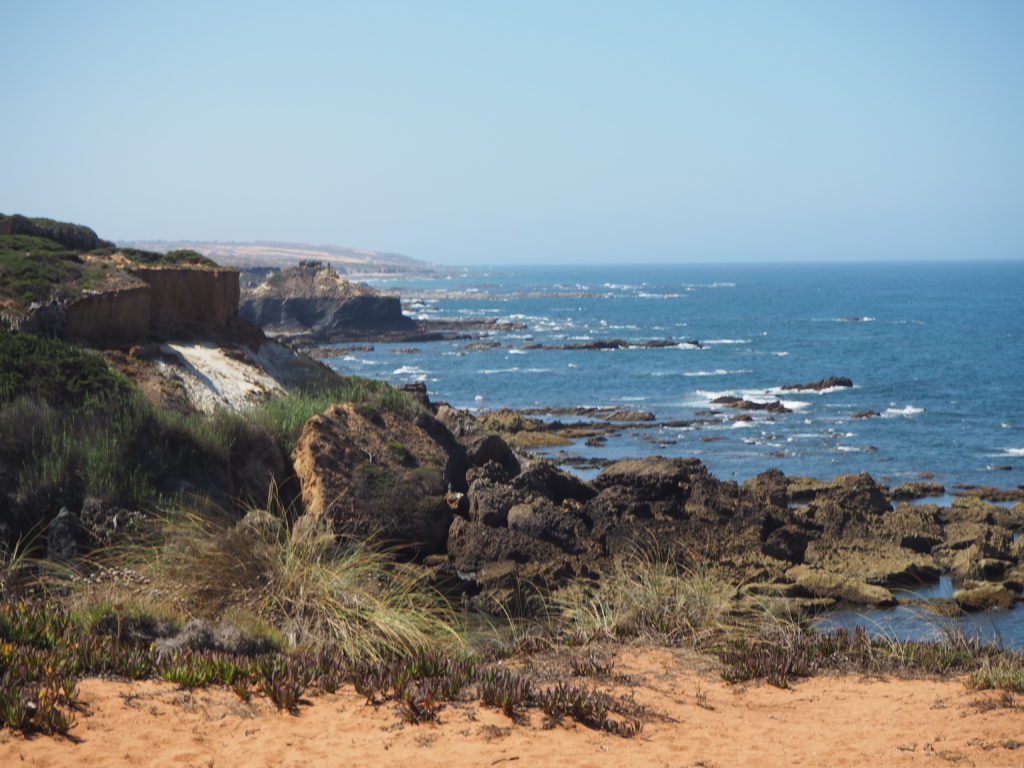
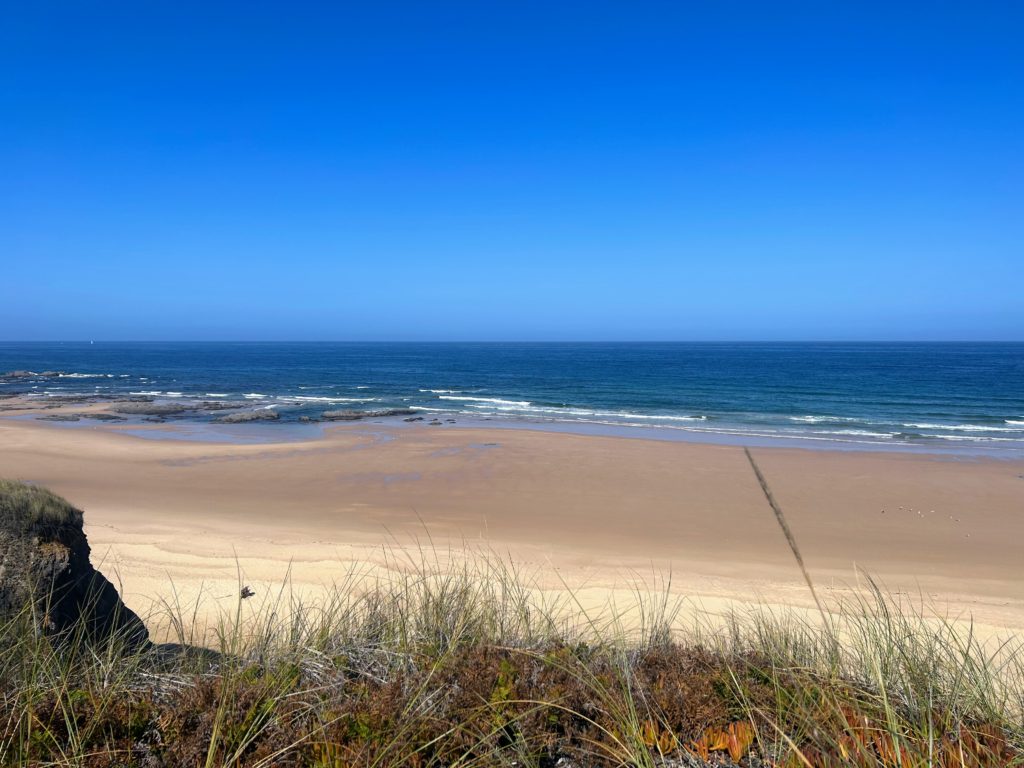
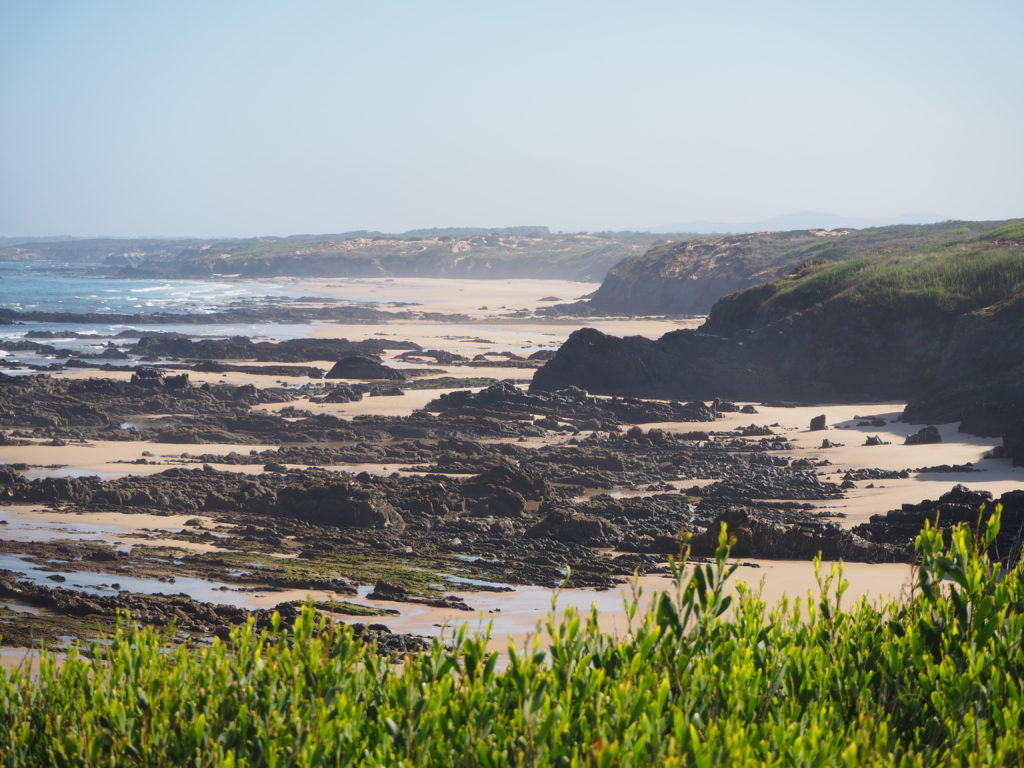
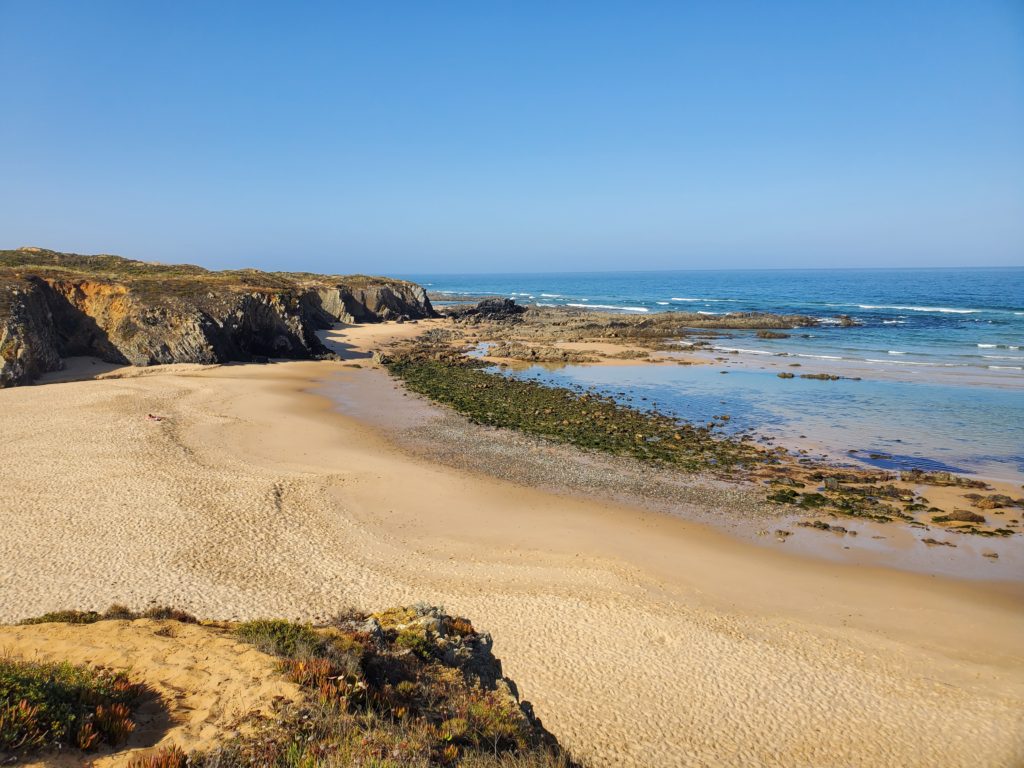
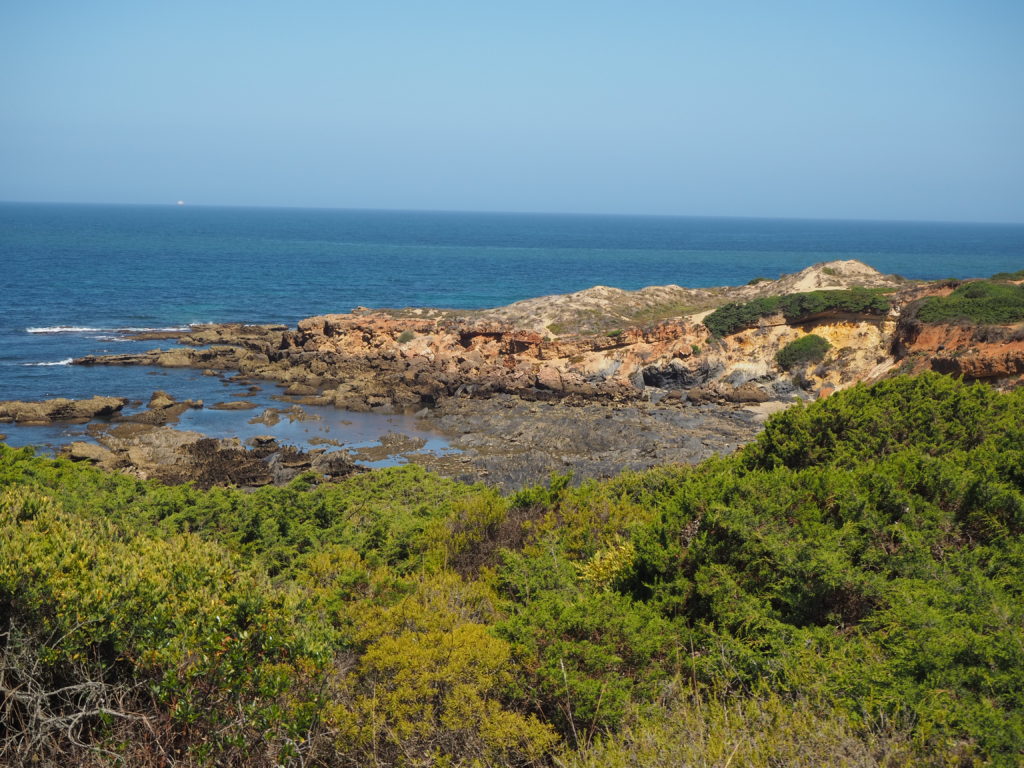
Day 5: Another bus.
Off to Lisbon! Back to the city life for a few days. We will see you there!

I can’t imagine it! I feel worn out just reading about your days of back pack hiking and the terrain does not sound or look easy. I take it this is mostly tourists doing this. Right? But I’m sure you are creating a great memorable experience . You do a great job writing. Look forward to the next one!
Lots of European tourists on the trail. Thank you!
Great photos as usual. Going with the literal & figurative flow, good call on managing your trekking boundaries.
Thanks for reporting on this this hike. It is on my list of things to do in Portugal. Your blog writing is very enjoyable to read.